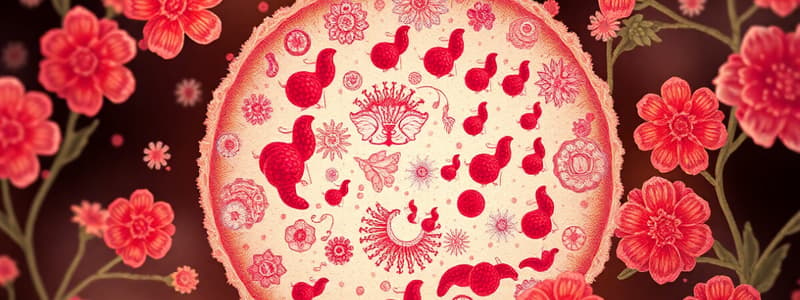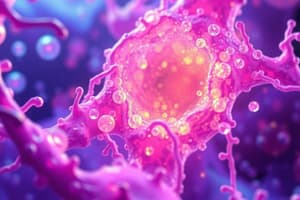Podcast
Questions and Answers
What is the primary role of the nucleus in a cell?
What is the primary role of the nucleus in a cell?
- To control the shape and support of the cell.
- To house the genetic material (DNA). (correct)
- To facilitate transportation of substances into and out of the cell.
- To produce energy for cellular functions.
Which component of the cell is primarily responsible for maintaining cell shape?
Which component of the cell is primarily responsible for maintaining cell shape?
- Cytoskeleton (correct)
- Cytoplasm
- Organelles
- Cell membrane
Which of the following is NOT a characteristic evaluated during cytological interpretation?
Which of the following is NOT a characteristic evaluated during cytological interpretation?
- Cellularity
- Cellular metabolism (correct)
- Nuclear features
- Cell morphology
What is the purpose of staining methods in the preparation of cytology specimens?
What is the purpose of staining methods in the preparation of cytology specimens?
Which of the following staining methods is commonly used in cytology?
Which of the following staining methods is commonly used in cytology?
What is the primary objective of cytology?
What is the primary objective of cytology?
Which technique involves the use of a thin needle to obtain a sample of cells?
Which technique involves the use of a thin needle to obtain a sample of cells?
In which application is cytology particularly important for cancer diagnosis?
In which application is cytology particularly important for cancer diagnosis?
What is the purpose of immunocytochemistry in cytological techniques?
What is the purpose of immunocytochemistry in cytological techniques?
Which cytological technique is commonly used for the screening of cervical cancer?
Which cytological technique is commonly used for the screening of cervical cancer?
Flashcards
What is cytology?
What is cytology?
The study of cells, how they work, and how diseases affect them.
What is fine-needle aspiration (FNA)?
What is fine-needle aspiration (FNA)?
A minimally invasive technique to take a sample of cells using a thin needle.
What is exfoliative cytology?
What is exfoliative cytology?
Examining cells shed from a surface, like the cervix or lungs, for early detection of diseases.
What is immunocytochemistry?
What is immunocytochemistry?
Signup and view all the flashcards
How does cytology help diagnose cancer?
How does cytology help diagnose cancer?
Signup and view all the flashcards
Cell Membrane
Cell Membrane
Signup and view all the flashcards
Cytoplasm
Cytoplasm
Signup and view all the flashcards
Nucleus
Nucleus
Signup and view all the flashcards
Organelles
Organelles
Signup and view all the flashcards
Chromatin/Chromosomes
Chromatin/Chromosomes
Signup and view all the flashcards
Study Notes
Introduction to Cytology
- Cytology is the study of cells, encompassing their structure, function, and pathology.
- It uses diverse techniques to evaluate cellular components and anomalies.
- Cytological examinations aid in diagnosis and research.
- The core goal is identifying and characterizing abnormal cells linked to disease.
Techniques in Cytology
- Fine-needle aspiration (FNA): Minimally invasive cell collection from tissues or organs using a thin needle.
- Impression smears: Direct pressure on tissue to collect cells on a slide.
- Exfoliative cytology: Collecting shed cells from surfaces (e.g., cervix, lungs) for examination, often in screenings.
- Cell block preparation: Consolidating cells into a solid block for better diagnostic clarity and preservation.
- Immunocytochemistry: Identifying specific cellular components using antibodies that target specific proteins.
- Molecular cytogenetics: Combining cytological and molecular biology techniques to study genetic material, including chromosomes.
Applications of Cytology
- Cancer diagnosis: Crucial for detecting and characterizing cancerous cells, aiding staging and treatment plans.
- Prenatal diagnosis: Pap smears (cervical) screen for cervical cancer and related precancers. Amniocentesis and CVS assess fetal chromosomes.
- Infectious disease diagnosis: Identifying characteristic cells indicative of viral, bacterial, or fungal infections.
- Autoimmune disease diagnosis: Detecting structural and functional cell changes related to autoimmune diseases.
- Research on cell biology: Cytology provides a microscopic view of differing cell types and their functions, using techniques like flow cytometry.
- Diagnosis of various diseases: Cytology offers a minimally invasive cell assessment from thyroid nodules to pulmonary lesions; results frequently guide further investigations and treatments.
Cellular Components Studied in Cytology
- Cell membrane: The outermost cell layer, regulating substance passage between the cell and its environment.
- Cytoplasm: The cell's internal substance containing organelles.
- Nucleus: The cell's control center housing the genetic material (DNA).
- Organelles: Specialized structures in the cytoplasm performing tasks (e.g., mitochondria, ribosomes, endoplasmic reticulum).
- Chromatin/Chromosomes: DNA's structural form crucial for cell division and traits.
- Cytoskeleton: Protein fibers maintaining cell shape and intracellular movement.
Key Principles in Cytological Interpretation
- Cell morphology: Analyzing cell shape, size, and cytoplasmic inclusions are key.
- Nuclear features: Evaluating nuclear size, shape, chromatin patterns, and nucleoli presence.
- Cellularity: Assessing cell abundance in a specimen.
- Cytoplasmic features: Examining cytoplasm for inclusions, vacuoles, and granules.
- Cell organization: Evaluating how cells are arranged in a sample.
- Contextual information: Clinical history and other diagnostic findings are vital for accurate interpretation.
Preparation of Cytology Specimens
- Specimen collection: Representative sample collection using appropriate methods is essential.
- Smear preparation: Essential steps involve air-drying, heat-fixing, and staining.
- Staining methods: Haematoxylin and Eosin (H&E), Papanicolaou (Pap) stains, and specialized stains are used regularly.
Conclusion
- Cytology offers a vast toolbox to assess cellular structural and functional changes.
- Cytology plays a key role in detecting, assessing, and tracking cell anomalies in disease diagnosis and treatment.
- Continued improvements in cytology techniques and instruments optimize analysis across many fields.
Studying That Suits You
Use AI to generate personalized quizzes and flashcards to suit your learning preferences.




